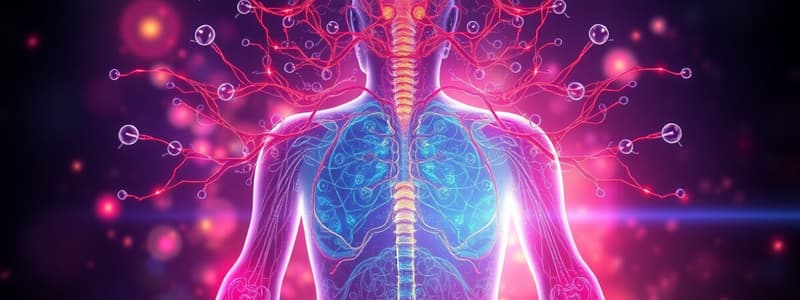Podcast
Questions and Answers
What is the primary function of the adrenal cortex?
What is the primary function of the adrenal cortex?
- Regulate glucose and salt levels in the blood (correct)
- Regulate sexual development
- Influence gene expression directly
- Control hormone release from the gonads
What distinguishes the release of sex steroid hormones between male and female gonads?
What distinguishes the release of sex steroid hormones between male and female gonads?
- Both release an equal amount of the three steroid categories
- Males release more estrogens than androgens
- Males release more androgens than estrogens (correct)
- Females release more androgens than estrogens
What role do tropic hormones play in the endocrine system?
What role do tropic hormones play in the endocrine system?
- Influence gene expression in gonads
- Stimulate secretion of hormones from other glands (correct)
- Regulate glucose levels directly
- Serve as the main source of sex steroid hormones
How does the endocrine function of males differ from females?
How does the endocrine function of males differ from females?
What type of tissue does the anterior pituitary gland develop from?
What type of tissue does the anterior pituitary gland develop from?
What hormone is released by the pituitary gland that stimulates the gonads?
What hormone is released by the pituitary gland that stimulates the gonads?
What was a significant finding from the study on male and female rats regarding pituitary glands?
What was a significant finding from the study on male and female rats regarding pituitary glands?
Which of the following categories of steroid hormones is NOT a sex steroid?
Which of the following categories of steroid hormones is NOT a sex steroid?
What is the primary function of endocrine glands?
What is the primary function of endocrine glands?
What type of cells do the testes produce?
What type of cells do the testes produce?
Which of the following hormones is classified as an amino acid derivative?
Which of the following hormones is classified as an amino acid derivative?
How many total hormones are released by the glands in the endocrine system?
How many total hormones are released by the glands in the endocrine system?
What determines the sex of the offspring at fertilization?
What determines the sex of the offspring at fertilization?
What is a characteristic feature of peptide hormones?
What is a characteristic feature of peptide hormones?
Which chromosome pair combination indicates a female offspring after fertilization?
Which chromosome pair combination indicates a female offspring after fertilization?
Which substances are not considered glands but can still release hormones?
Which substances are not considered glands but can still release hormones?
Study Notes
Glands
- Two main types of glands:
- Exocrine Glands: Release chemicals into ducts for transport to target locations, primarily on the body surface (e.g., sweat glands).
- Endocrine Glands: Ductless; secrete hormones directly into the circulatory system, targeting various organs (including other endocrine glands).
- Organs such as the stomach, liver, intestines, and body fat can release hormones and are part of the endocrine system despite not being classified as glands.
- Primary function of glands is hormonal release; there are 10 major endocrine glands.
Gonads
- Specific endocrine glands related to sex:
- Male (Testes): Produce haploid sperm cells (23 chromosomes) containing half of the genetic material.
- Female (Ovaries): Produce haploid egg cells (23 chromosomes) with similar genetic material constraints.
- A zygote forms upon fertilization of an egg by a sperm cell, resulting in a diploid cell (46 chromosomes).
- 22 of the 23 chromosome pairs are autosomal (non-sex chromosomes); the 23rd can be X or Y in sperm, always X in eggs.
- Offspring sex determination:
- XY = male
- XX = female
Hormones
- Three categories of vertebrate hormones:
- Amino Acid Derivatives: Synthesized from a single amino acid (e.g., Epinephrine from adrenal medulla).
- Peptide and Protein Hormones:
- Peptide: Short chains (e.g., Oxytocin).
- Protein: Long chains (e.g., Human growth hormone).
- Steroid Hormones: Derived from cholesterol; affect sexual development and behavior.
- Small, fat-soluble molecules that can penetrate cell membranes and influence gene expression.
- Sex steroids from gonads include:
- Androgens: E.g., Testosterone.
- Estrogens: E.g., Estradiol.
- Progestins: E.g., Progesterone.
- Both male and female gonads release all three sex steroid categories, but:
- Testes release more androgens.
- Ovaries release more estrogens.
Adrenal Gland
- Functions as an endocrine gland.
- The adrenal cortex regulates glucose and salt levels in blood.
- Produces small quantities of sex steroid hormones released by gonads.
Pituitary Gland
- Known as the master gland; regulates hormone release from gonads.
- Distinct regions play different roles:
- Anterior Pituitary: Originates from embryonic roof of the mouth, releases tropic hormones, and exerts master gland qualities.
- Posterior Pituitary: Develops from hypothalamic tissue, connected to the hypothalamus.
- Tropic hormones stimulate other glands to release hormones (e.g., gonadotropic hormone stimulates gonads).
- Hormonal release patterns:
- Males: Constant levels of gonadotropic and gonadal hormones.
- Females: Cyclical release every 28 days.
Research Findings
- Anterior pituitary glands switched between male and female rats showed hormonal changes:
- Cyclical function in female rats became consistent in males.
- Steady function in male rats became cyclical in females.
- Concludes that the pituitary gland is controlled by another structure in the nervous system.
Studying That Suits You
Use AI to generate personalized quizzes and flashcards to suit your learning preferences.
Description
Explore the differences between exocrine and endocrine glands in this quiz. Learn how these glands function in the neuroendocrine system, focusing on their roles and the types of chemicals they release. This foundational knowledge is crucial for understanding hormonal interactions in the body.




